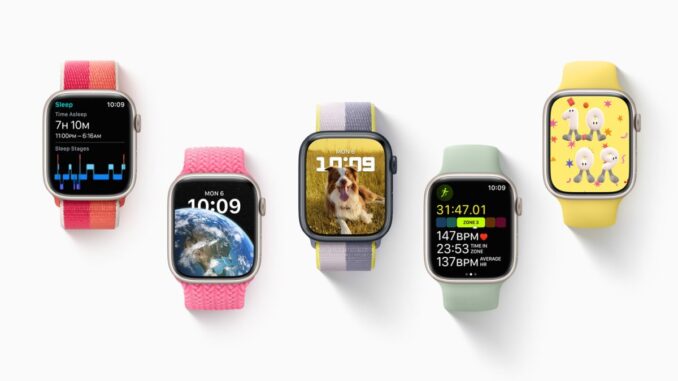
Apple today previewed watchOS 9, which brings new features and enhanced experiences to the world’s leading wearable operating system. Apple Watch users will now have more watch faces to choose from, with richer complications that provide more information and opportunity for personalization. In the updated Workout app, advanced metrics, views, and training experiences inspired by high-performing athletes help users take their workouts to the next level. watchOS 9 brings sleep stages to the Sleep app, and a new FDA-cleared AFib History feature provides deeper insights into a user’s condition. The new Medications app makes it easy for users to conveniently and discreetly manage, understand, and track medications.
“Users around the world love Apple Watch for helping them stay connected to those they love, be more active throughout the day, and better manage their health,” said Jeff Williams, Apple’s chief operating officer. “This fall, watchOS 9 takes the Apple Watch experience to the next level with scientifically validated insights across fitness, sleep, and heart health, while providing users more creative ways to make their Apple Watch their own.”
Watch Faces for Everyone
The Apple Watch experience starts with watch faces, which give users the opportunity to express personal style while connecting them to relevant information at a glance through complications. watchOS 9 introduces four new faces: Lunar, which depicts the relationship between the Gregorian calendar and lunar calendar, used in many cultures such as Chinese, Islamic, and Hebrew; Playtime, a dynamic piece of art that’s unique to Apple Watch and created in collaboration with artist Joi Fulton; Metropolitan, a classic, type-driven watch face where the style changes as the Digital Crown is rotated; and Astronomy, an original face that has been completely remastered and features a new star map and current cloud data.
watchOS 9 introduces enhanced and modernized complications on some of the most classic watch faces, such as Utility, Simple, and Activity Analog, along with background color editing for Modular, Modular Compact, and X-Large for additional personalization. The new Portraits face showcases the depth effect on more photos, including cats, dogs, and landscapes, while Chinese scripts have been added as options for California and Typograph watch faces. Focus now allows users to select an Apple Watch face to automatically appear when they start a specific Focus on iPhone, such as the Photos face during a Personal Focus, helping users stay in the moment.
Workout App Updates
The Workout app, one of the most popular apps on Apple Watch, has been updated to provide richer metrics for measuring performance, as well as new training experiences to help users reach fitness goals. The familiar in-session display now uses the Digital Crown to rotate between easy-to-read Workout Views, so users can see important metrics for different training styles. Heart Rate Zones, which can be manually created or automatically calculated using personalized Health data, can be used to monitor the intensity of a workout. Interval training is an important part of any training plan, and in watchOS 9, the Workout app introduces Custom Workouts, which can be used to create a structured workout that can include work and rest intervals. New alerts, including pace, power, heart rate, and cadence, can be added to guide users throughout the workout.
For triathletes, the Workout app now supports a new Multisport workout type that automatically switches between any sequence of swimming, biking, and running workouts, using motion sensors to recognize movement patterns. When each workout is complete, a redesigned summary page in the Fitness app offers additional details with interactive charts for more precise analysis.
Hit the Ground Running
Apple Watch is already a powerful tool for runners, and watchOS 9 brings more data and features to help track how efficiently users run. New running form metrics, including Stride Length, Ground Contact Time, and Vertical Oscillation, can all be added as metrics on Workout Views. These metrics appear in the Fitness app summary and in the Health app, where users can see trends over time and learn from patterns.
Users can choose to race against their best or last result on frequently used routes, and receive alerts during the workout for being ahead or behind their pace, as well as when going off route. Additionally, a new pacer experience lets users choose a distance and goal for the time in which they want to complete a run, and calculates the pace required to achieve the goal. During the workout, they can follow the pace alerts and metrics provided.
Swimming Enhancements
Kickboard detection has been added as a new stroke type for Pool Swim workouts, using sensor fusion on Apple Watch to automatically detect when users are swimming with a kickboard and classify the stroke type in the workout summary along with distance swam. Swimmers can now track their efficiency with a SWOLF score — a stroke count combined with the time, in seconds, it takes to swim one length of the pool. Users can view their SWOLF average for each set in the workout summary.
Get More Out of Apple Fitness+ Workouts
Apple Fitness+ is the first fitness and wellness service built around Apple Watch, designed to be welcoming to all. It intelligently incorporates real-time workout metrics from Apple Watch right on the screen with iPhone, iPad, or Apple TV, motivating users of all levels from start to finish. With watchOS 9, Fitness+ workouts now display on-screen guidance in addition to trainer coaching to help users get the most out of workouts, including: Intensity for HIIT, Cycling, Rowing, and Treadmill; Strokes per Minute (SPM) for Rowing; Revolutions per Minute (RPM) for Cycling; and Incline for walkers and runners in Treadmill.
Fitness+ subscribers without Apple TV can now use AirPlay to stream workouts and meditations with on-screen metrics to compatible third-party TVs and devices, allowing them to train anywhere, anytime.
Sleep Insights
The Sleep experience on Apple Watch already empowers users to create Wind Down and Bedtime schedules, as well as track their sleep to help them meet their goals. Sleep tracking in watchOS 9 provides even more insights with the introduction of sleep stages. Using signals from the accelerometer and heart rate sensor, Apple Watch can detect when users are in REM, Core, or Deep sleep. Users will see sleep stage data on Apple Watch in the Sleep app and can view more detailed information, like time asleep, alongside additional metrics, like heart rate and respiratory rate, in sleep comparison charts in the Health app on iPhone.
The machine learning models were trained and validated against the clinical gold standard, polysomnography, with one of the largest and most diverse populations ever studied for a wearable. As the science of sleep is still being explored, users will be able to aid in potential discoveries by contributing their sleep stage data in the Apple Heart and Movement Study through the Research app.
First-of-Its-Kind AFib History
Currently, the ECG app and irregular rhythm notification on Apple Watch can identify potential signs of atrial fibrillation (AFib). Left untreated, AFib is one of the leading conditions that can result in stroke.
Research suggests that the amount of time spent in AFib may impact a person’s symptoms, overall quality of life, and risk of complications. Previously, there has not been an easy way to track the frequency of AFib over an extended period of time, or to manage lifestyle factors that may influence one’s condition. According to the American Heart Association, addressing modifiable lifestyle factors may decrease the amount of time spent in AFib.1
With watchOS 9, users who are diagnosed with AFib can turn on the FDA-cleared AFib History feature2 and access important information, including an estimate of how frequently a user’s heart rhythm shows signs of AFib, providing deeper insights into their condition. Users will also receive weekly notifications to understand frequency and view a detailed history in the Health app, including lifestyle factors that may influence AFib, like sleep, alcohol consumption, and exercise.
Users can download a PDF with a detailed history of their AFib and lifestyle factors, which can easily be shared with doctors and care providers for more informed conversations.




Be the first to comment